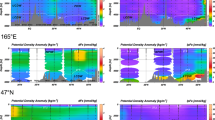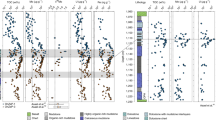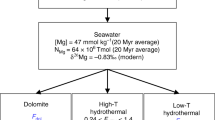Abstract
Two decades ago, Merrihue1 reported 3He/4He ratios of >10−4 in ferromagnetic separates from a Pacific deep ocean red clay and concluded that the high ratio is due to extraterrestrial debris amounting to ∼1% of the sediment. A decade later Krylov et al.2 compiled 3He/4He isotopic data on ocean sediments measured in the Soviet Union and observed that the 3He/4He ratio is generally higher in pelagic sediments where the sedimentation rate is lower. They suggested that the high 3He/4He ratio was attributable to extraterrestrial materials which were concentrated in slowly accumulating ocean floor. However, these important discoveries were almost completely neglected until we re-examined the problem. We have measured 39 sediments from 12 different sites, 10 sites from the western to central Pacific and two sites from the Atlantic Ocean. We find 3He/4He ratios >5 × 10−5 for six sites, well above the values generally observed in common terrestrial materials. The very high 3He/4He ratio in the sediments is probably due to input of extraterrestrial materials. Input of stratospheric dust of ≲1 p.p.m., which corresponds to a fallout rate of ∼2,000 tons per year, can explain the observation.
This is a preview of subscription content, access via your institution
Access options
Subscribe to this journal
Receive 51 print issues and online access
$199.00 per year
only $3.90 per issue
Buy this article
- Purchase on Springer Link
- Instant access to full article PDF
Prices may be subject to local taxes which are calculated during checkout
Similar content being viewed by others
References
Merrihue, C. Ann. N.Y. Acad. Sci. 119, 351–367 (1964).
Krylov, A. Ya., Mamyrin, B. A., Silin, Yu. I. & Khabarin, L. V., Geochem. Int. 10, 202–205 (1973).
Init. Rep. DSDP. 43, 19–321 (1979).
Init. Rep. DSDP 43, 323–391 (1979).
Kobayashi, K., Tonouchi, S., Furuta, T. & Watanabe, M. Bull. Ocean Res. Inst. Univ. Tokyo No. 13, 1–148 (1980).
Prelim. Rep. of the Hakuho Maru Cruise KH80-3, 209 (Ocean Research Institute, University of Tokyo, 1981).
Ozima, M., Zashu, S. & Nitoh, O. Geochim. cosmochim. Acta, 47, 2217–2224 (1983).
Ozima, M. & Zashu, S. Science 219, 1067–1068 (1983).
Kaneoka, I. & Takaoka, N. Earth planet. Sci. Lett. 39, 382–386 (1978).
Ozima, M. & Podosek, F. A. Nobel Gas Geochemistry, 367 (Cambridge University Press, 1983).
Tolstikhin, I. N. in Terrestrial Rare Gases, (eds Alexander, E. C. Jr & Ozima, M.) 33–62 (Japan Science Society Press, 1978).
Podosek, F. A., Honda, M. & Ozima, M. Goechim. cosmochim. Acta 44, 1875–1884 (1980).
Hughes, D. W. in Cosmic Dust (ed. McDonnell, J. A. M.,), 123–185 (Wiley, New York 1978).
Rajan, R. S. et al. Nature 267, 133–134 (1977).
Author information
Authors and Affiliations
Rights and permissions
About this article
Cite this article
Ozima, M., Takayanagi, M., Zashu, S. et al. High 3He/4He ratio in ocean sediments. Nature 311, 448–450 (1984). https://doi.org/10.1038/311448a0
Received:
Accepted:
Issue Date:
DOI: https://doi.org/10.1038/311448a0
This article is cited by
-
Impacts of Cosmic Dust on Planetary Atmospheres and Surfaces
Space Science Reviews (2018)
-
He, Ne and Ar isotopic composition of Fe-Mn crusts from the western and central Pacific Ocean and implications for their genesis
Science in China Series D: Earth Sciences (2007)
-
Helium isotope investigation on magnetic reversal boundaries of loess-paleosol sequence at Luochuan, central Chinese Loess Plateau
Chinese Science Bulletin (2007)
-
Subduction of solar-type noble gases from extraterrestrial dust: constraints from high-pressure low-temperature metamorphic deep-sea sediments
Contributions to Mineralogy and Petrology (2005)
-
Extraterrestrial3 He in marine polymetallic nodules: A potential method for measuring growth rate of nodules
Science in China Series B: Chemistry (2002)
Comments
By submitting a comment you agree to abide by our Terms and Community Guidelines. If you find something abusive or that does not comply with our terms or guidelines please flag it as inappropriate.



